Winners of the 2024 Autovista Group Residual Value Awards
29 October 2024

The Autovista Group Residual Value Awards celebrate cars with market-leading value retention across eight categories. Autovista24 editor Tom Geggus reveals this year’s winning models and market trends.
After analysing data from 17 European countries, the results of the 2024 Autovista Group Residual Value Awards are in. With multiple categories split across segments, body types and powertrains, the outcomes highlight an important industry trend.
’Premium and affordable models are major money makers for carmakers,’ explained Dr Christof Engelskirchen, chief economist at Autovista Group. ‘So, it is unsurprising that both premium and budget brands performed well in the 2024 residual value awards (RV) awards.’
After securing prominent placing in three categories last year, Dacia enjoyed enormous success in 2024 with three models crowned winners. The carmaker provided sensible upgrades to its models as consumers opted for greater affordability amid more economic uncertainty.
Small Car category
Contenders in the Small Car category compete for price-sensitive buyers who do not need a large vehicle. 42 models made the 2024 category shortlist, reaching the top five in at least one of the 17 countries analysed.
However, the grouping has become narrower, with fewer very small models appearing. Diesel and plug-in hybrid (PHEV) powertrains were also absent. Instead, most cars in the category were equipped with either petrol engines or full-hybrid (HEV) drives.
Several battery-electric vehicles (BEVs) did compete within the grouping. Yet, these cars were unable to compete with the RVs of their internal-combustion engine (ICE) competitors. This is why small BEVs also competed within a unique category.
The category did see a range of body types and sizes, as hatchbacks went up against SUVs and small vehicles. This meant competition between the Fiat 500 (3.6 meters long), and the Toyota Yaris Cross (4.2 meters long).
Award success for Dacia Sandero
The Dacia Sandero claimed victory in the Small Car category this year. While available as a standard hatchback, Dacia also offers a rugged Stepway version, which has SUV styling with high suspension and roof rails.
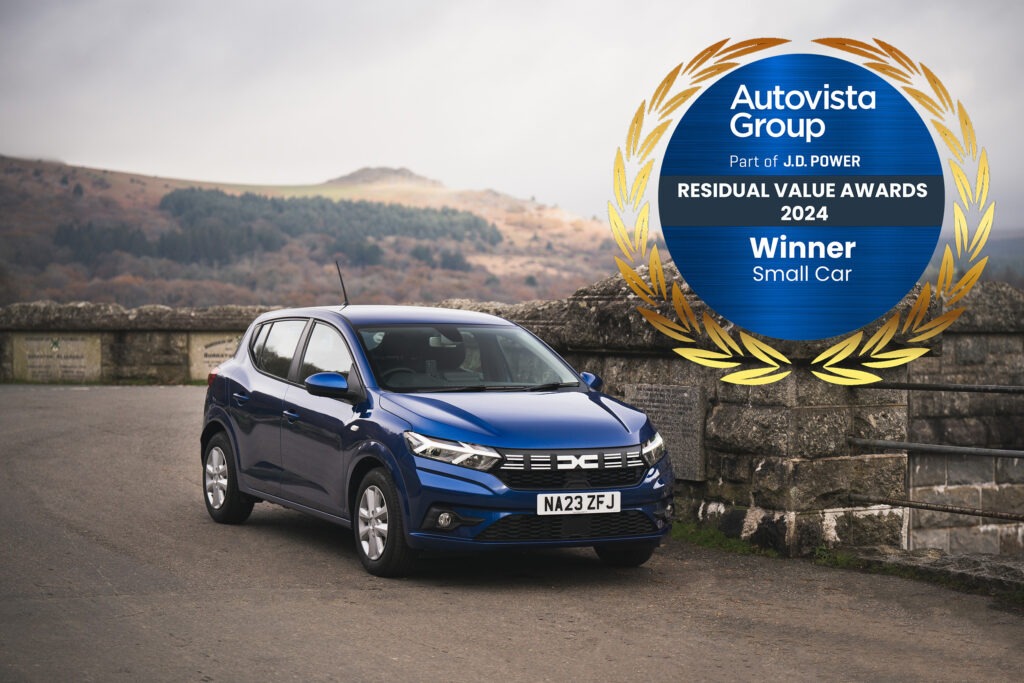
‘The Dacia Sandero was introduced in 2021 but got equipment and design upgrades in 2024. Its price-performance ratio is unbeaten for many buyers in the smaller-vehicle segment,’ said Engelskirchen. ‘What works well on new-car markets seems to work equally well on used-car markets for Dacia.’
Many European countries are recording historically high demand for smaller cars from the A and B-segments, explained Christian Schneider, director of content at EV Volumes.
‘Recent years have seen rising new-car prices alongside marginal economic growth, driving demand for small, affordable cars across Europe. So, it is not surprising that Europe’s most affordable car, the Dacia Sandero, reached pole position in this price-sensitive category,’ he added.
After coming first in 2023, the latest edition of the Mini took second, while its new Countryman sibling came third. While both small cars competed from a strong premium position, they could not overtake Dacia.
The Toyota Yaris Cross claimed fourth thanks to a remarkable used-car market performance. The model is clearly benefitting from the Toyota hybrid brand effect. The new Citroën C3 Aircross finished fifth as a fresh SUV offering in the segment.
Small BEV category
‘Over the last decade, the number of large and expensive BEVs being launched has only grown. Meanwhile, mass market adoption is the real challenge facing the powertrain,’ Engelskirchen explained.
The number of small BEVs available on used-car markets is still limited. However, there has been a significant number of new launches recently. This meant that 24 different models were short-listed in the Small BEV category this year.
All of these vehicles made it into the top five in at least one of the 17 countries analysed. This collection of models included all body types between the A and B-segments, with SUVs competing with small hatchbacks.
Award for Mini Aceman
There were high-performing BEVs in the top five. This included the Dacia Spring, the Hyundai Kona, the Fiat 600 and the Alfa Romeo Junior, meaning there was a choice across budgets. Many small BEVs performed consistently in multiple European markets.

‘But the brand new Mini Aceman beat them all,’ Engelskirchen revealed. ‘It features the typical Mini DNA in terms of style, practicability and premium ambitions. Its futuristic look makes it stick out in the segment, while it conserves and upgrades Mini design cues.’
However, BEVs still struggle for wider mass-market traction. A primary reason for this is the lack of small and affordable cars, Schneider explained. Even as the number of small BEVs grows, there is still a lack of affordable cars for many customers.
Taking second place, the Dacia Spring demonstrated how targeting this gap in the market can pay off. Lifecycle depreciation is now playing a crucial role for BEVs, with the recently launched Mini Aceman leading the pack.
Compact Car category
The compact segment combines good size with attractive prices and offers an abundance of choices. However, SUVs made such a big impact on this part of the market that they now dominate the segment. SUVs are therefore excluded from the Compact Car category.
‘Yet, the classic hatchback is still alive and kicking,’ Engelskirchen outlined. ‘Another high-performer in this category is the multi-purpose vehicle (MPV), which could see a comeback in the coming years.’
Buyers looking for high efficiency and good prices, while avoiding SUVs, can still be overwhelmed by what is on offer. A total of 33 models made it into the top five in at least one of the 17 markets analysed.
Joy for Dacia Jogger
The winner in the Compact Car category this year was the Dacia Jogger. It offers all the qualities of a seven-seater van and is available for around €21,000.
‘Consumers tightened their purse strings while inflation climbed, making economic choices vitally important,’ said Engelskirchen. ‘The Jogger is a deserving winner.’
‘However, premium-level models also performed well. The Audi A3 finished second, ahead of the BMW 1 Series, Volkswagen (VW) Golf and Mercedes-Benz CLA.’
‘Compact cars offer a great alternative to the compact SUV segment. It contains a diverse range of powertrains as well as a wide variety of models and body types. This includes hatchbacks, coupés and MPVs,’ Schneider said.
MPVs have fallen out of favour in new-car markets over the last few years. Many compact MPVs saw their production come to an end, such as the Ford C-Max. Others experienced a conceptual shift towards an SUV design, like the Peugeot 3008.
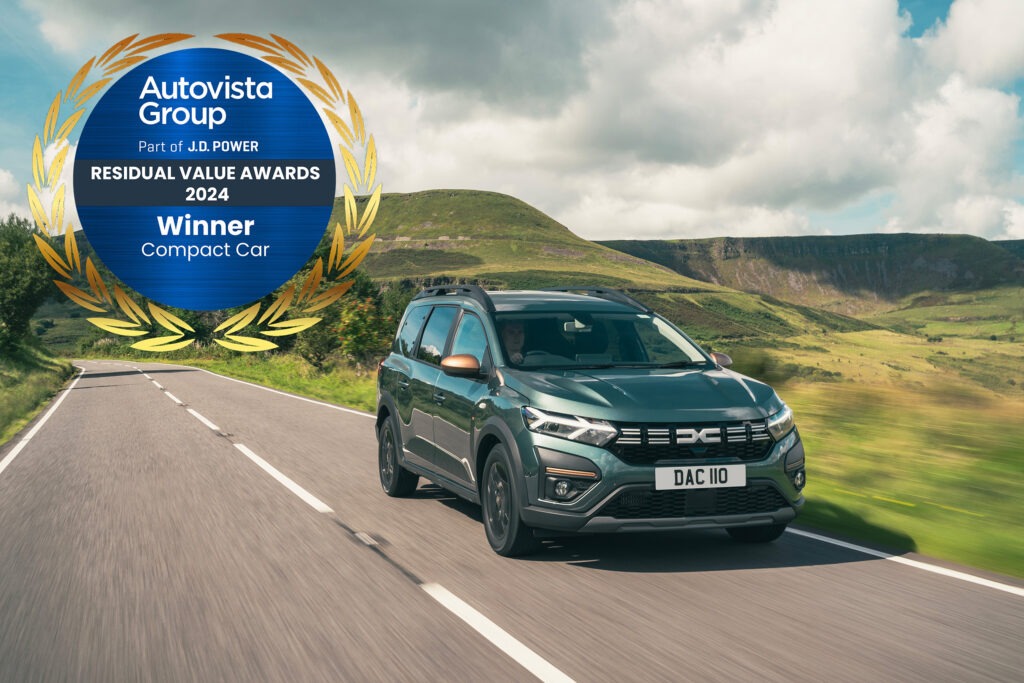
‘This has meant a lower supply of used MPVs, which has had a positive effect on RVs. Combined with Dacia’s unbeaten value for money, the Jogger successfully took first place in the Compact Car category,’ Schneider added.
Compact SUV category
The highly competitive Compact SUV category saw 31 vehicles make it into the top five across the 17 countries analysed.
‘The compact SUV segment is currently the most popular in Europe, offering a wide variety of options for all needs,’ Schneider said. ‘There was a wide range of BEVs in the category as well. This included established OEMs like BMW and Stellantis as well as new players such as BYD and Zeekr.’

‘The economic choice once again beat premium offerings,’ Engelskirchen commented. ‘Dacia claimed victory in the category with the new Duster. Europe’s best-seller is now available as a hybrid, and features improved quality as well as a larger price tag.
Last year’s winner, the Mercedes-Benz GLA, claimed third. It was beaten by the BMW X1, which found a remarkable sweet spot among the other SUVs in the segment. The BMW X2 came fourth while the reputable Hyundai Tucson followed in fifth.
As in most other categories, BEV RVs fell behind ICE and PHEV models. The BMW iX2 was the highest-ranking BEV in the category, coming 28th overall.
Triple award win for Dacia
‘We are very proud to receive this triple award which rewards the residual values of Dacia Sandero, Jogger and Duster,’ Xavier Martinet, Dacia’s senior vice president of marketing, sales and operations told Autovista24.
‘It is the result of a long-term strategy that applies to all our lineup: a unique business model based on offering net prices rather than discounts and focusing on retail customers with a very limited usage of tactical channels,’ he continued.
‘This sales and marketing policy is the best protection for our residual values. These high RVs are one of the fundamental elements explaining the growth of the Dacia brand in Europe as we are posting best-level loyalty rates. Two out of three Dacia customers opt to stay in the brand when they renew their vehicle.
‘Our objective is clearly to continue applying this successful strategy in the future, which will be even more important as we are about to enter the C-SUV segment in Europe for the first time with the all-new Dacia Bigster,’ Martinet concluded.
Large Car category
The Large Car category saw more than 30 models make it into the top five across the 17 countries reviewed. This underscores the diversity of the segment, meaning plenty of choices for consumers. Vans were included in the segment while SUVs were excluded, the same as the 2023 awards.
Incumbent OEMs with more premium offerings saw the greatest levels of value retention. This included Mercedes-Benz, BMW, and VW. These marques excelled thanks to considerable brand strength, each with several models making it high up the rankings.
Mercedes-Benz masterclass
The Mercedes-Benz V-Class held on to its title from 2023, taking the top spot in the Large Car category. The overall winner also finished in the top five of 10 different markets, often towards the very top.
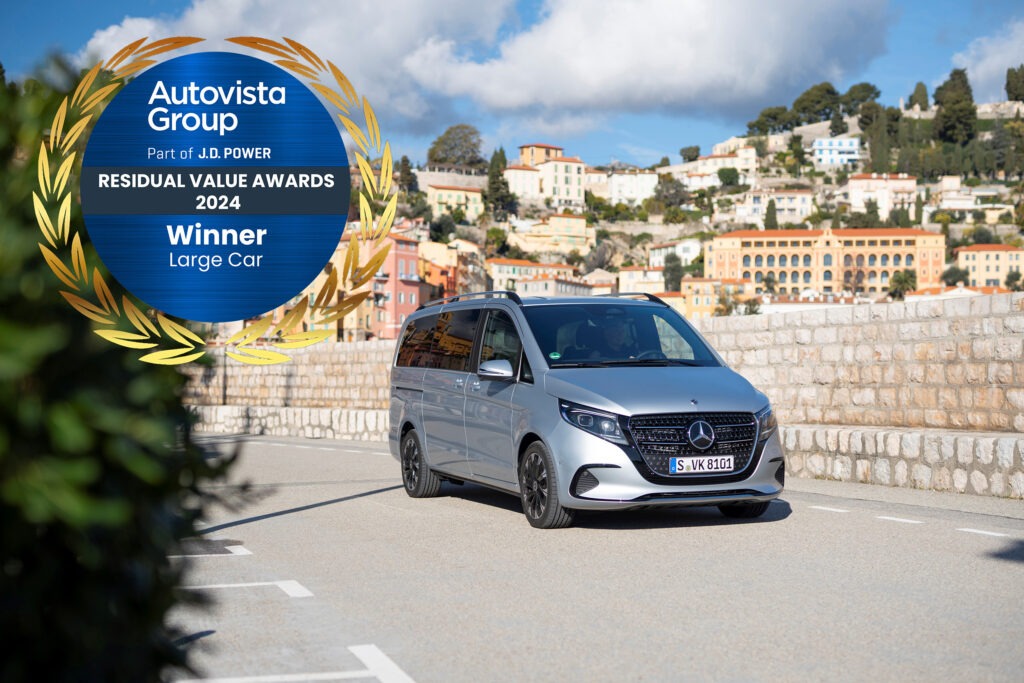
‘The V-Class was not the brand’s only high-performing model in the category. Mercedes-Benz also took third with the elegant E-Class and fourth with the stylish CLE,’ said Engelskirchen. However, Mercedes-Benz was up against some tough competition.
The BMW 3 Series, which had a facelift in 2022 and received some feature touch-ups in 2024, came second. It is a force to be reckoned with in used-car markets with a long-lasting appeal.
Brand and versatility are strong sales points, carrying weight on the new and used-car markets. Additionally, vans are very attractive in the used-car market. Accordingly, the VW T7 also performed well, taking fifth place.
‘The European large-car segment is traditionally dominated by premium manufacturers from Germany and is characterised by a high fleet share,’ Schneider commented. ‘This is visible in our top five tables.’
There is a low supply of MPVs hitting the used-car market as fewer of these vehicles are produced. This category is also heavily influenced by the desire for premium quality. This has helped push the RVs of the Mercedes-Benz V-Class skywards.
Large SUV category
‘Years ago, this segment is where SUVs began their journey to become the dominant body type,’ said Engelskirchen. The Large SUV category saw a solid lineup. A total of 30 models made it to the top five across the 17 countries examined.
‘Large SUVs show the highest RV levels among all cars in Europe, due to their high desirability,’ Schneider explained. ‘Unsurprisingly many brands are offering a big range of models in this popular European category.’
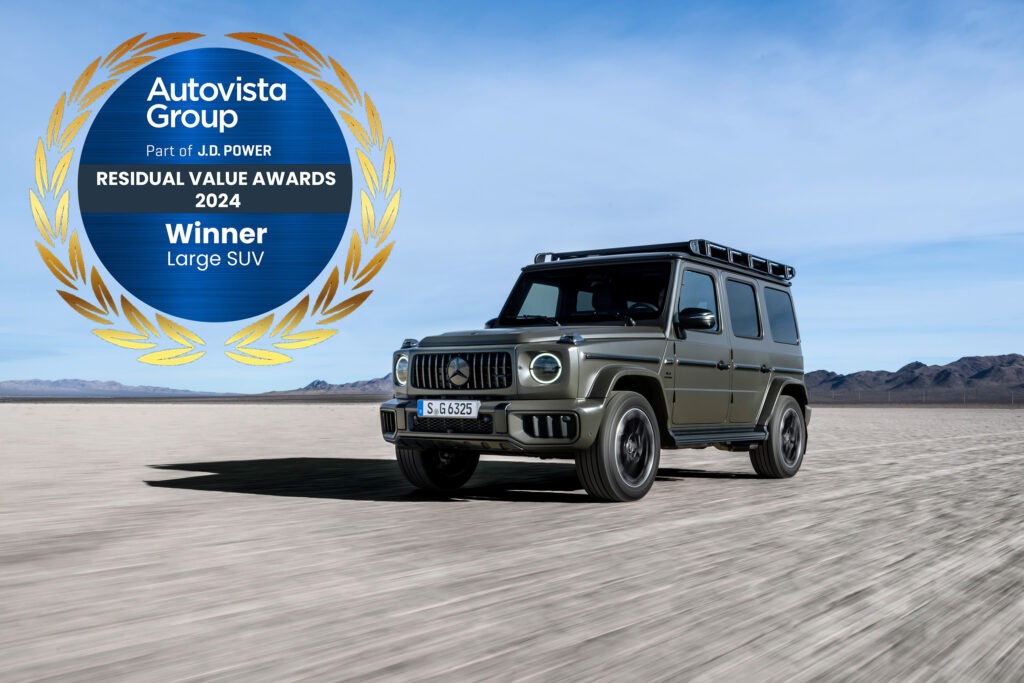
The Mercedes-Benz G-Class celebrated category-leading RVs following a refresh in 2024. It made it into the top five across 11 markets, where it consistently outperformed its contenders. Last year’s winner, the Land Rover Defender, secured second place. It was followed by the Mercedes-Benz GLC Coupé, the Toyota Landcruiser and the Porsche Cayenne.
‘It is remarkable that in this highly competitive category, three off-road-legends made it into the top five table. This includes the Mercedes-Benz G-Class, the Land Rover Defender and the Toyota Landcruiser,’ Schneider said.
‘Their iconic design and heritage, combined with relatively low sales numbers and an image of indestructibility, help them achieve the highest RVs in Europe,’ he added.
There were also a sizeable number of BEVs present in this category. However, they could not compete with the value retention of ICE models.
‘The iconic G-Class and standard-setting V-Class both received significant updates and upgrades this year. It is great that their enduring popularity has been recognised with these Autovista Group Residual Value Awards,’ said Rob Halloway, director of communications at Mercedes-Benz cars and vans.
Compact and Large BEV category
‘There is a wide variety of body types in the rapidly growing Compact and Large BEV category,’ said Engelskirchen. ‘The aim here was to give non-SUVs a chance to shine.’
A total of 28 different non-SUV BEVs reached the top five at least once in the 17 countries analysed, compared with 19 models last year. The model with the greatest value retention in this category was the BMW i5. The brand-new BEV was able to beat last year’s winner, the i4, which finished second.
The Tesla Model 3 continued to perform well, taking third. It recently received a facelift, helping it maintain a good RV positioning. It made it into the top five for value retention in 12 of the 17 markets. The VW ID.7 claimed fourth ahead of the Porsche Taycan, which recently received several technical upgrades across its variants.
This category highlights the rapid improvement of electric vehicle (EV) technology. A vehicle that had a fantastic range two or three years ago is average by today’s standards, Schneider explained.
‘Used-car buyers are seeing this too and models which are further along in their lifecycle are penalised due to their technology,’ he added. ‘All of the models in the top five are relatively new and feature state-of-the-art batteries.’
BMW builds benchmarks
‘We are delighted to accept this Autovista Group Residual Value Award for the BMW i5,’ said Nicole Mattig, head of corporate sales for Europe, BMW.

‘Available with an all-electric powertrain for the first time, the eighth-generation BMW 5 Series marries benchmark driving dynamics with an array of innovative technology, including advanced driver-assistance systems, the BMW curved display and My Modes for a customisable driving experience.
‘This, combined with an exceptionally high level of standard specification, ensures a compelling product offering for our most discerning customers across Europe,’ she said.
Compact and Large BEV SUV category
SUVs dominate the BEV market, with an ever-growing number of competing models. A total of 40 vehicles made it into the top five in at least one of the 17 markets analysed. This was up from only 27 models in 2023.
Porsche risked it all when offering the brand-new Macan with only a BEV powertrain. This strategy appears to have paid off with the model claiming the lead in such a competitive category.
‘Desirability has always been a strong selling point for Porsche, helping to boost its RVs,’ commented Engelskirchen. ‘This holds true for the Macan, which also comes with a solid WLTP range over 600km.’
The Kia EV9 took second, beating the BMW iX2 in third and the Volvo EX90 in fourth. The Mini Countryman was renewed this year, helping it to claim fifth.
Schneider pointed towards an ongoing conceptual conundrum for OEMs. They are trying to decide between dedicated BEVs and those built on mixed architectures, with ICE versions also on offer.
‘From an RV perspective there is currently no clear choice, he said. ‘In this category, the top five featured pure BEVs like the Porsche Macan, Kia EV9 and Volvo EX90. But there were also mixed-platforms like BMW iX2 or Mini Countryman.’
Ten years of success
‘The Macan has been a successful model for Porsche for over ten years,’ said Jörg Kerner, vice president of the Macan product line.
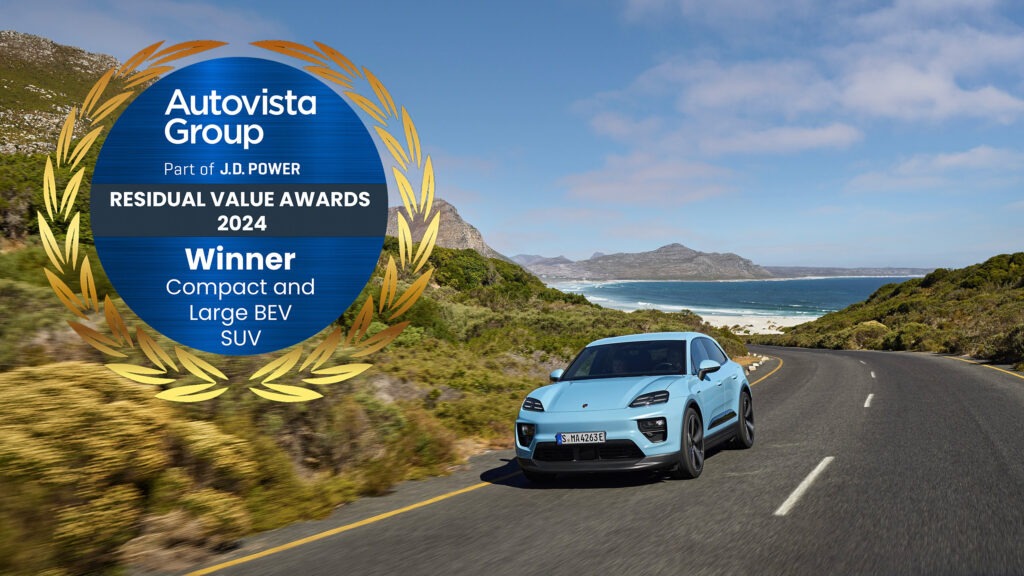
‘With the sportiest offering in the B-SUV segment, we have been able to win new markets and target groups for the brand. We have now taken the Macan to a completely new level, with exceptional E-performance, the new driver experience and expressive design.
‘We currently offer four models that cover a wide spectrum at a high-performance level with up to 470kW. In addition, Porsche combines its design DNA with aerodynamics designed to optimize range and consumption. The drag coefficient of 0.25 is the benchmark in the segment.
‘The overwhelming response from our customers and the media as well as winning the 2024 Autovista Group Residual Value Award make me confident that the Macan's success story will continue in the all-electric version,’ Kerner concluded.




